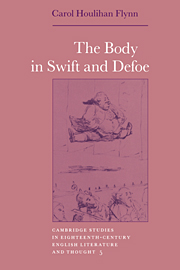Book contents
- Frontmatter
- Contents
- Acknowledgments
- List of abbreviations
- Introduction “The Dearness of things”: the body as matter for text
- 1 Dull organs: the matter of the body in the plague year
- 2 The burthen in the belly
- 3 Consuming desires: Defoe's sexual systems
- 4 Flesh and blood: Swift's sexual strategies
- 5 The ladies: d—ned, insolent, proud, unmannerly sluts
- 6 Chains of consumption: the bodies of the poor
- 7 Consumptive fictions: cannibalism in Defoe and Swift
- 8 Vital parts: Swift's necessary metaphors
- Afterword Suppose me dead; and then suppose
- Index
1 - Dull organs: the matter of the body in the plague year
Published online by Cambridge University Press: 21 September 2009
- Frontmatter
- Contents
- Acknowledgments
- List of abbreviations
- Introduction “The Dearness of things”: the body as matter for text
- 1 Dull organs: the matter of the body in the plague year
- 2 The burthen in the belly
- 3 Consuming desires: Defoe's sexual systems
- 4 Flesh and blood: Swift's sexual strategies
- 5 The ladies: d—ned, insolent, proud, unmannerly sluts
- 6 Chains of consumption: the bodies of the poor
- 7 Consumptive fictions: cannibalism in Defoe and Swift
- 8 Vital parts: Swift's necessary metaphors
- Afterword Suppose me dead; and then suppose
- Index
Summary
'Tis a speaking Sight, says he, and has a Voice with it, and a loud one, to call us all to Repentance; and with that he opened the Door and said, Go, if you will.
A Journal of the Plague Year, p. 61.He look'd into the Pit again, as he went away, but the Buriers had covered the Bodies so immediately with throwing in Earth, that tho' there was Light enough, for there were Lantherns and Candles in them plac'd all Night round the Sides of the Pit, upon the Heaps of Earth, seven or eight, or perhaps more, yet nothing could be seen.
A Journal of the Plague Year, p. 62.One of the central concerns of the Journal is epistemological. Defoe's narrator, the curious, skeptical H.F., spends much of his time trying to interpret the phenomenon of the plague year. He addresses problems of perception – how can he see anything at all – and problems of interpretation – how can he understand what he is trying to observe. In his compulsion to make sense of the materials in his way, he demonstrates the problem of his age, the difficulty of reconciling a yearning for large patterns to the resistance the materials themselves bring. H.F. stands as a man of religious faith crossing warily over into the age of enlightenment, a man who consults his bible to plan his course but demonstrates at the same time that providential patterns cannot quite hold the plague in place.
- Type
- Chapter
- Information
- The Body in Swift and Defoe , pp. 8 - 36Publisher: Cambridge University PressPrint publication year: 1990

